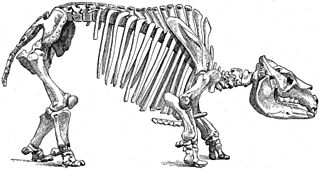
Notoungulata is an extinct order of mammalian ungulates that inhabited South America from the early Paleocene to the Holocene, living from approximately 61 million to 11,000 years ago. Notoungulates were morphologically diverse, with forms resembling animals as disparate as rabbits and rhinoceroses. Notoungulata are the largest group of South American native ungulates, with over 150 genera in 14 families having been described, divided into two major subgroupings, Typotheria and Toxodontia. Notoungulates first diversified during the Eocene. Their diversity declined from the late Neogene onwards, with only the large toxodontids persisting until the end of the Pleistocene, perishing as part of the Quaternary extinction event among with most other large mammals in the Americas. Collagen analysis suggests that notoungulates are closely related to litopterns, another group of South American ungulates, and their closest living relatives being perissodactyls, including rhinoceroses, tapirs and equines as part of the clade Panperissodactyla. However their relationships to other South American ungulates are uncertain. Several groups of notoungulates separately evolved ever-growing cheek teeth.

Mesotheriidae is an extinct family of notoungulate mammals known from the Oligocene through the Pleistocene of South America. Mesotheriids were small to medium-sized herbivorous mammals adapted for digging.

Typotheria is a suborder of the extinct mammalian order Notoungulata and includes five families: Archaeopithecidae, Campanorcidae, Interatheriidae, Mesotheriidae, and Oldfieldthomasiidae. Cifelli indicated that Typotheria would be paraphyletic if it excluded members of the suborder Hegetotheria and he advocated inclusion of the hegetothere families Archaeohyracidae and Hegetotheriidae in Typotheria.
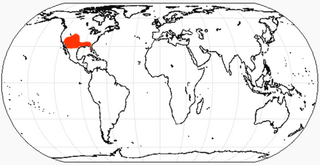
Carpocyon is an extinct genus of the Borophaginae subfamily of canids native to North America. It lived from the Middle to the Late Miocene, 13.6 to 5.3 Ma Mya, existing for approximately 16.5 million years. The four species in the genus varied in size, with the largest being about the size of a wolf; all had relatively small teeth, suggesting a diet that was more omnivorous than that of other contemporary borophagines.
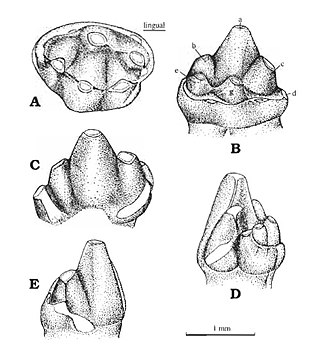
Woutersia was a Triassic genus of 'symmetrodont' and the only representative of the family Woutersiidae. It was originally classified as a kuehneotheriid, but it has been suggested that it may be related to Docodonta. Remains of W. mirabilis and W. butleri have been found in the Gres à Avicula contorta Formation at Saint-Nicolas-de-Port, France, while W. mirabilis has been found in Varangéville, France; remains have been dated to the Late Triassic, 205.6 to 201.6 Ma.
The North American land mammal ages (NALMA) establishes a geologic timescale for North American fauna beginning during the Late Cretaceous and continuing through to the present. These periods are referred to as ages or intervals and were established using geographic place names where fossil materials were obtained.

The Barstovian North American Stage on the geologic timescale is the North American faunal stage according to the North American Land Mammal Ages chronology (NALMA), typically set from 16,300,000 to 13,600,000 years BP, a period of 2.7 million years. It is usually considered to overlap the Langhian and Serravallian stages of the Middle Miocene. The Barstovian is preceded by the Hemingfordian and followed by the Clarendonian NALMA stages.
The Deseadan age is a period of geologic time within the Oligocene epoch of the Paleogene to the Early Miocene epoch of the Neogene, used more specifically within the SALMA classification of South America. It follows the Tinguirirican and precedes the Colhuehuapian age.
The Colhuehuapian age is a period of geologic time within the Early Miocene epoch of the Neogene, used more specifically within the SALMA classification in South America. It follows the Deseadan and precedes the Santacrucian age.

The Malargüe Group is a group of geologic formations of the Neuquén Basin of the Mendoza, Neuquén, Río Negro and La Pampa Provinces in northern Patagonia, Argentina. The formations of the Malargüe Group range in age between the middle Campanian to Deseadan, an Oligocene age of the SALMA classification, straddling the Cretaceous–Paleogene boundary, about 79 million to 30 million years in age. The group overlies the older Neuquén Group, separated by an unconformity dated to 79 Ma. The rocks of the Malargüe Group comprise both marine and continental deposits which are over 400 m (1312 ft) thick in total.
Griphotherion is an extinct genus of notoungulate mammal from the Eocene of Argentina. A fossil skeleton was found in the Lumbrera Formation and described in 2011 as the holotype of the type species G. peiranoi.
Hypsitherium is an extinct genus of Mesotheriidae that lived 4.0 to 3 million years ago. It is known from the Miocene to Pliocene Inchasi fossil locality in Bolivia. Hypsitherium was a scansorial herbivore, and its name translates to "high beast."

Miocochilius is an extinct genus of small notoungulate mammals (typotheres) native to South America. The genus lived during the Middle Miocene epoch. The genus contains two described species, the type species M. anomopodus described in 1953 by Ruben Arthur Stirton and M. federicoi, described and included in the genus by Darin A. Croft.

Hegetotherium is an extinct genus of mammals from the Early to Middle Miocene of South America. Fossils of this genus have been found in the Cerro Bandera, Cerro Boleadoras, Chichinales, Collón Curá, Santa Cruz and Sarmiento Formations of Argentina, the Nazareno Formation of Bolivia, and the Galera and Río Frías Formations of Chile.

Prosotherium is an extinct genus of hegetotheriid notoungulate. It lived during the Late Oligocene, and its fossilized remains were found in South America.
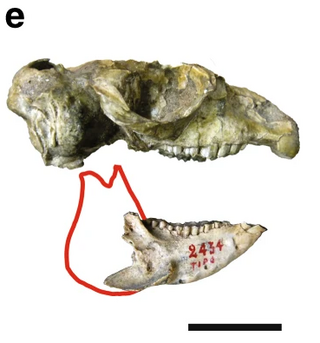
Tremacyllus is an extinct genus of hegetotheriids. It lived from the Late Miocene to the Late Pleistocene and its fossilized remains were discovered in South America.
Medistylus is an extinct genus of pachyrukhine hegetotheriid. It lived in Argentina during the Late Oligocene. Medistylus is known from its upper teeth and isolated skulls, however, its lower dentition is currently unknown. Its fossilized remains were found at the Cabeza Blanca and Las Cascadas localities of the Sarmiento Formation in Chubut Province of Argentina.
Ethegotherium is an extinct genus of Notoungulates, belonging to the suborder Typotheria. It lived from the Lower to the Middle Miocene, and its fossilized remains were discovered in South America. It might be a synonym of the genus Prohegetotherium.
Eohyrax is an extinct genus of Notoungulate, belonging to the suborder Typotheria. It lived during the Middle Eocene, and its remains were discovered in South America.
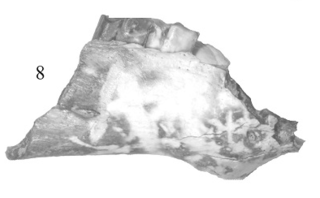
Eopachyrucos is an extinct genus of interatheriid notoungulates that lived from the Middle Eocene to the Late Oligocene of Argentina and Uruguay. Fossils of this genus have been found in the Sarmiento Formation of Argentina and the Fray Bentos Formation of Uruguay.




















